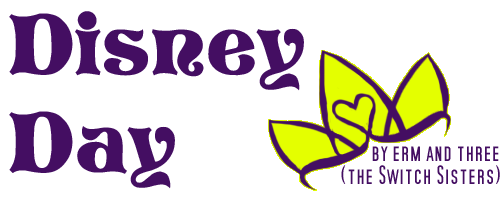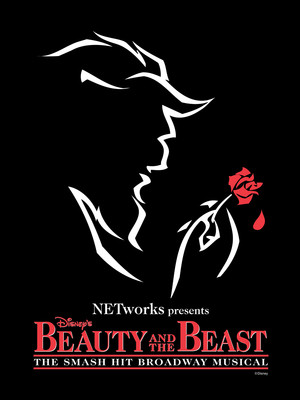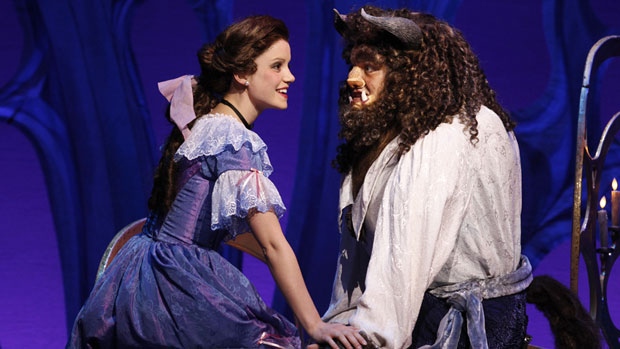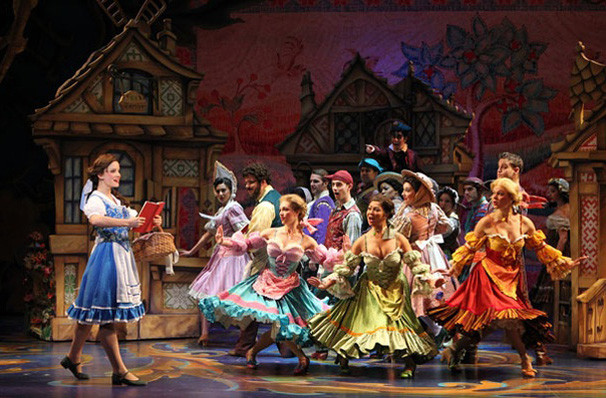

I saw Beauty and the Beast at the Princess of Wales Theatre in Toronto.
I’m fairly new to the Disney musical scene – aside from Beauty and the Beast, the only other one I’ve seen is The Lion King, and I was way too young for critical analysis at the time.
Still, I was excited about Beauty because I have so. many. complaints about the Disney animated feature. I won’t get into that now, because what I want to talk about is how the show improved on the animated feature – and how it didn’t.
The Beauties
- The show gives the servants the time of day! A highlight for me was Mrs. Potts, who, when Lumiere and Cogsworth decide it’s time to give up, reminds them that her son has been turned into a cup. We see the servants gathering to talk about their chances; talk about what they can do to help to break the curse. Although in the animated feature, the servants want to hook the Beast up with Belle, it seems to play off as something they just want to do for their master – not because it will give them their lives back.
Human Again, which is present in newer versions of the animated movie, was left out of the original – and it really does add a crucial detail to the plot, which is that the Beast has more riding on this than his own aesthetic. - BEAST. If I Can’t Love Her is the Beast’s solo. (Remember, he didn’t have that in the animated.) We see Beast start to ask himself some important questions – why is it so hard for him to be a gentleman to Belle? Why does he keep having temper tantrums instead of behaving like an actual person? Basically, he concludes that if he can’t fall in love with this beautiful, kind, intelligent girl – he’s pretty much doomed. Which seems to be a fair assessment.
No beauty could move me
No goodness improve me
No power on earth, if I can’t love her
No passion could reach me
No lesson could teach me
How I could have loved her and made her love me too
If I can’t love her, then who?
- BELLE! Now, Belle never stops being kind of elitist. (One of the problems I have with the animated feature). But Belle’s character is famously quixotic, and in the musical, we actually address that in A Change in Me, in which she addresses her own character growth – “no change in heart, but change in me”, as it were. She’s still the bookish intelligent woman we know her to be, but she has also come back down to earth, which is good – it proves that she actually gained something from this experience, on an individual level. We also get to hear about her feelings more in Home, which is great, because… why didn’t we before? She was being held captive in an enchanted castle, and all we got was “Well, I am a little hungry.” Is that all, Belle?
As my life has been altered once it can change again
Build higher walls around me
Change every lock and key
Nothing lasts nothing, holds all of meMy heart’s far far, away
Home and, free
- The title romance. erm and I always felt that Beast was a little whiny, so when Beast dropped to the stage floor and started having a full-out temper tantrum, I couldn’t handle how perfect that was. Hilarious and perfect. In the animated feature, we’re almost asked to forget the fact that Beast behaves like a spoiled child, instead focusing on his rage issue. But the rage is a better colour on him when he’s actually just being immature, and Belle is the first person in his life to actually put him in his place. In the story that follows, the two stand up to each other, bond over their shared love of escapism, and in the end, as Beast points out, she hasn’t been his prisoner for a while. Instead, they are two stand-out personalities who compliment each other.
The Beasts
- Let’s not forget that Belle is still a prisoner. Her character development is basically this: She wished she could escape from her boring provincial life, then she got kidnapped, and she learned to appreciate what she has. Er… thanks, Beast, I guess.
- There’s still no reason why Belle couldn’t return to the castle with her father – the only place she’s ever really felt like she belonged – when Beast lets her go and save him. I mean, really. He doesn’t have to resign himself (and his servants) to death because of that. No one filled that plot hole.
- The show created this weird Gaston/Lefou dynamic which I didn’t know what to do with. In the animated feature, Lefou was just your typical one-dimensional comic relief sidekick. The show, on top of that, added a bunch of “Gaston and Lefou are gay, LOL” jokes. Among many others were the scenes where Gaston was interacting with the bimbettes, and he’d kiss each girl, then kiss Lefou, then punch him in the face. These jokes were both not funny and confusing. Who was that meant to appeal to? Why did they think that was appropriate? I don’t get it.
[EDIT: Well, I wasn’t going to get into this any further because no one needs my straightsplaining, but this morning I came across this post (about Deadpool) which gets into the whole “we assume that overtly gay statements are a joke” thing and I’ll share it because it’s better.]
- The show didn’t improve on the classist/elitist theme of the animated feature. The bimbettes still exist, for one thing, and the townspeople are still a dehumanized mass of illiterate people who just don’t get it. It felt close to home, in these trying political times, when the villagers set out to destroy the Beast because he was new and scary, but it’s also dangerous to equate literacy with worth – and to put women down for wanting to be with a guy like Gaston. Basically, Disney, maybe you should watch Aladdin or something.
Riff-raff, street rat, I don’t buy that
If only they’d look closerWould they see a poor boy?
No siree, they’d find out there’s so much more to me.
– The Bimbettes, probably





